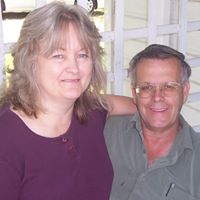Roger M Skaggs
Deceased
from Bonne Terre, MO
Roger Skaggs Phones & Addresses
- 2903 Bess Rd, Bonne Terre, MO 63628 • 5733585736
- 5513 Highway D, Farmington, MO 63640 • 5737561407
- Spring Creek, NV
- 2903 Bess Rd, Bonne Terre, MO 63628
Work
-
Company:International tool corporation
-
Address:10144 State Highway Aa, Potosi, MO 63664
-
Phones:5734361011
-
Position:President
-
Industries:Power-Driven Handtools
Education
-
Degree:Associate degree or higher
Resumes

Public Works
view sourceWork:
City of Greensburg
Public Works
Public Works
Skills:
Pump Stations
Electrical Troubleshooting
Electricians
Operations Management
Pumps
Water Distribution
Public Works
Construction Management
Electrical Troubleshooting
Electricians
Operations Management
Pumps
Water Distribution
Public Works
Construction Management

Owner
view sourceLocation:
Bonne Terre, MO
Industry:
Mining & Metals
Work:
International Tool Corporation
Owner
Owner

Roger Skaggs
view source
Roger Skaggs
view source
Roger Skaggs
view source
Roger Skaggs
view source
Roger Skaggs
view sourceName / Title
Company / Classification
Phones & Addresses
President
International Tool Corporation
Power-Driven Handtools
Power-Driven Handtools
10144 State Highway Aa, Potosi, MO 63664
Owner, President
International Tool Corporation
Mfg Power-Driven Handtools · Power-driven Handtools
Mfg Power-Driven Handtools · Power-driven Handtools
10144 State Hwy Aa, Potosi, MO 63664
Potosi, MO 63664
5734361011, 5734361457
Potosi, MO 63664
5734361011, 5734361457
Organizer
INTERNATIONAL TECHNOLOGIES LLC
Manufacturing · Plastics and Rubber Products Manufacturing · Plastic Products Manufacturing · Whol Chemicals/Products
Manufacturing · Plastics and Rubber Products Manufacturing · Plastic Products Manufacturing · Whol Chemicals/Products
5 Main St, Elkins, WV 26241
7430 House Rd, Bonne Terre, MO 63628
3046367929
7430 House Rd, Bonne Terre, MO 63628
3046367929
Us Patents
-
Drillhole Blasting
view source -
US Patent:7052092, May 30, 2006
-
Filed:Nov 19, 2001
-
Appl. No.:10/432405
-
Inventors:Stephen Mitchell Collinsworth - Stanton KY, US
Nils Alberto Heinke - Elkins WV, US
Roger Dean Skaggs - Bonne Terre MO, US -
International Classification:F24D 1/08
E21C 37/16 -
US Classification:299 13, 102333
-
Abstract:A blasting arrangement () includes drillholes () in a rock mass (). Blind ends () are drilled to a desired level and, if necessary, are adjusted as shown at () to said level. Each hole () is plugged by means of a plug (), which is protected by non flammable buffer material (), at a level () spaced from the end (). Explosive () is charged above the level () and the hole is tamped, shown at (). The holes are detonated desirably by detonators (), forcing the plugs () downwardly and compressing air in chambers () above the ends (). The weakest part of each hole, around the end (), is split causing a three dimensional zone of weakness at the level of the ends (). Air forced into the zone of weakness causes a fracture zone () at that level, inhibiting propagation of blasting shock waves and protecting the material underneath the level of the ends ().
-
Blasting Method And Blasting Accessory
view source -
US Patent:7387071, Jun 17, 2008
-
Filed:Sep 30, 2004
-
Appl. No.:10/574324
-
Inventors:Nils Alberto Heinke - Elkins WV, US
Roger Dean Skaggs - Bonne Terre MO, US
Stephen Mitchell Collinsworth - Stanton KY, US -
Assignee:International Technologies, LLC - Elkins WV
-
International Classification:F42D 3/00
-
US Classification:102313, 102333, 299 13
-
Abstract:A drill hole () extends into rock to be blasted. A blasting accessory () includes a container portion () for holding a predetermined volume of stemming material, and a spacer () for spacing the stemming material a predetermined distance from a surface, e. g. a blind bottom of the drill hole. The container portion has a top () surrounded by a dilatable, inverted skirt forming a seal (), and forms a support for a blasting substance like an explosive.
-
Blasting
view source -
US Patent:20070272109, Nov 29, 2007
-
Filed:Sep 30, 2004
-
Appl. No.:10/574377
-
Inventors:Nils Heinke - Elkins WV, US
Roger Skaggs - Bonne Terre MO, US
Stephen Collinsworth - Stanton KY, US -
International Classification:F42D 1/08
-
US Classification:102312000
-
Abstract:In blasting rock, a drill hole () is charged with spaced, composite layers (), () at different levels between an open mouth () and a blind bottom (). Each composite layer is supported on a plug (). Flowable plunger material (), e.g. drill cuttings, is supported on the respective plug followed by blast material (), topped by a further layer of plunger material (). The plunger material () at the top, is in the form of tamping. The composite layers are spaced respectively from one another and optionally, from the bottom (). Initiators () can be actuated by means of a controller to initiate the blasting material to displace the layers of plunger material at speed to collide, e.g. with the bottom and with one another to concentrate enemy at the collision sites.
-
Roller Cone Bit
view source -
US Patent:20130075162, Mar 28, 2013
-
Filed:Sep 22, 2011
-
Appl. No.:13/239660
-
Inventors:Roger D. Skaggs - Farmington MO, US
-
International Classification:E21B 7/00
E21B 10/08 -
US Classification:175 57, 175340
-
Abstract:A roller cone bit is described. The roller cone bit includes a body having concave sides. Legs are attached or integral to the body. Roller cones are rotatably engaged to the legs. The concave sides are positioned adjacent the legs. A nozzle is positioned in an approximately central portion of the body.
-
Hammer Bit
view source -
US Patent:20140069722, Mar 13, 2014
-
Filed:Sep 12, 2012
-
Appl. No.:13/611760
-
Inventors:Roger D. Skaggs - Farmington MO, US
-
International Classification:E21B 10/38
E21B 10/36
E21B 7/00 -
US Classification:175 57, 175415
-
Abstract:A hammer bit is herein described with tapered lateral sides and a modified face section. The tapered lateral sides taper inward towards a rear portion of the hammer bit. The modified face section includes a gauge portion and a larger angled or heel portion. The hammer bit provides improved penetration and directional control for drilling into the earth.
-
Drill Bit Having A Plurality Of Teeth
view source -
US Patent:56474482, Jul 15, 1997
-
Filed:Jan 11, 1996
-
Appl. No.:8/585025
-
Inventors:Roger Dean Skaggs - Bonne Terre MO
-
International Classification:E21B 1042
E02F 300 -
US Classification:175421
-
Abstract:A drill bit for placement on a trenchless drill, the drill bit having a substantially rectangular construction, opposed side edges, a front end edge angularly related to the side edges, and a back end edge opposite the front end edge, opposed faces, with the edges having holes located therein and a cutting tooth press punched into each of the holes to form interference fits between the cutting teeth and the drill bit, the drill bit further having mechanism for attachment of the drill bit to the trenchless drill.
-
Rock Drill Bit
view source -
US Patent:49536427, Sep 4, 1990
-
Filed:Mar 20, 1989
-
Appl. No.:7/326079
-
Inventors:Roger D. Skaggs - Bonne Terre MO
-
International Classification:E21B 1044
E21B 1060 -
US Classification:175393
-
Abstract:A rock drill bit having an elongated tubular body with a drilling head portion at one end and a trailing opposite end portion, the head end portion having attached hardened portions for engaging and drilling a work surface, at least one opening through the head end portion for drilling fluid to pass therethrough to the region of the drill face, at least one side of the bit having an axially extending cutout therealong forming an elongated passage with the surface of a bore being drilled through which the drilling fluid and drilling residue carried thereby can pass as it moves rearwardly along the drill bit away from the drill face, and transversely extending grooves formed in the portions of the body between the cutouts dividing the portions into a plurality of spaced outwardly extending body portions.
Googleplus

Roger Skaggs

Roger Skaggs
view source
Roger Skaggs
view source
Roger Skaggs
view source
Roger Skaggs
view source
Roger Skaggs
view source
Roger Skaggs
view source
Roger Skaggs
view source
Roger Skaggs
view sourceClassmates

Roger Skaggs
view sourceSchools:
Eastern High School Middletown KY 1978-1982
Community:
Gina Padgett, Cecil Trabue

Roger Skaggs
view sourceSchools:
Greensburg High School Greensburg KY 1968-1972
Community:
Debora Waldman, Robert Judd

Roger Allen Skaggs
view sourceSchools:
Potosi High School Potosi MO 1970-1974
Community:
Anita Yates, Bob Hamby, Cheryl Portell
Myspace
Youtube
Get Report for Roger M Skaggs from Bonne Terre, MODeceased








